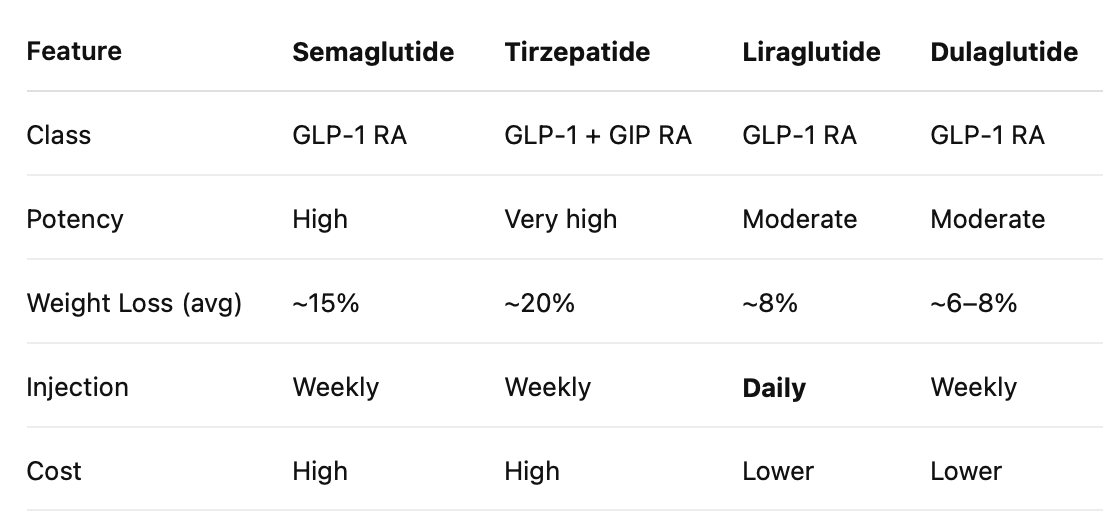Understanding the Landscape — and What It Means for Your Weight Loss Journey
If you’re one of the thousands of patients who started your weight loss journey with semaglutide (like Ozempic® or Wegovy®) or tirzepatide (like Mounjaro® or Zepbound®), you may be surprised — and frustrated — to hear that your provider or pharmacy is recommending a switch to a different medication like liraglutide or dulaglutide.
You’re not alone. And more importantly, you’re not out of options.
🚨 Why the Switch?
There are a few common reasons patients are being transitioned to older GLP-1 medications like liraglutide or dulaglutide:
-
Cost – Semaglutide and tirzepatide are often expensive, and not all insurance plans cover them.
-
Insurance Denials – Coverage can be inconsistent, especially for patients without diabetes.
-
Shortages – Ongoing supply constraints have made it difficult for clinics and pharmacies to consistently offer these medications.
-
Access Models – Some providers are turning to compounded or plain alternatives to offer patients more affordable options.
In response, many pharmacies and telehealth platforms (including major players like HIMS® and others) are now offering liraglutide or dulaglutide as more accessible GLP-1 alternatives. But that doesn’t mean you’re getting the same experience.
⚠️ What’s the Difference Between Semaglutide, Tirzepatide, Liraglutide, and Dulaglutide?
Let’s be clear: while all these medications fall under the GLP-1 umbrella, not all GLP-1s are created equal.

Key takeaway: Older GLP-1s like liraglutide and dulaglutide are less potent, less convenient, and offer slower results. Most patients report more hunger, weight plateaus, and less satisfaction when switching from semaglutide or tirzepatide.These older medications can still help — but most patients experience slower results, less appetite control, and a higher chance of plateauing if used alone.
🧠 The Science Behind the Gap
Why do patients lose more weight on semaglutide and tirzepatide?
It comes down to metabolic support. Tirzepatide, for example, targets two hormones (GLP-1 and GIP), while semaglutide is stronger and longer-lasting than liraglutide. Both deliver greater improvements in:
-
Appetite suppression
-
Insulin sensitivity
-
Fat breakdown
-
Satiety and cravings
Unfortunately, liraglutide and dulaglutide don’t provide this same level of support. That means if you’re switching to them, you may feel hungrier, lose weight more slowly, or hit a plateau sooner.
What to Expect When Switching to Plain GLP-1 Therapy
If you’re moving from a next-gen GLP-1 to liraglutide or dulaglutide, it’s important to set realistic expectations. Here’s what many patients report:
-
Slower fat loss and metabolic progress
-
Return of appetite or food noise
-
Less satiety after meals
-
Increased fatigue or carb cravings
These medications simply weren’t designed to deliver the kind of results that tirzepatide or semaglutide offer. But that doesn’t mean you have to settle.
🔄 But There’s Good News
If you’re transitioning to a plain GLP-1 like liraglutide or dulaglutide, there’s a way to keep your progress on track — and possibly even improve your outcomes.
It’s called SLM+.
💡 What Is SLM+?
SLM+ is a science-backed metabolic optimizer developed to support patients on GLP-1 therapy — especially those using plain GLP-1s like liraglutide or dulaglutide.
It contains three powerful natural ingredients that:
-
Enhance insulin sensitivity
-
Support GLP-1 and GIP-like pathways
-
Reduce blood sugar spikes and cravings
-
Boost energy and fat metabolism
Think of SLM+ as the missing link for older GLP-1s — a way to bring your protocol closer to the results you had (or expected) on semaglutide or tirzepatide. SLM+'s ingredients synergize with GLP-1 receptor agonists to boost metabolism, suppress cravings, and prevent plateaus.
🧪 Will It Really Help?
While liraglutide alone delivers about 8% average body weight loss over 12 months, internal projections suggest that adding SLM+ can push results to 10–13%, particularly in patients with insulin resistance or metabolic slowdown.

That could mean an extra 7–12 pounds lost for someone weighing 200 lbs — without increasing your GLP-1 dose.
✅ What to Do Next
-
Talk to Your Provider: Ask if you’re a candidate for SLM+ as part of your new GLP-1 plan.
-
Visit our SLM+ product page to learn more or place an order
-
Check Your Pharmacy: Many clinics and pharmacies now stock SLM+ — or you can order directly at www.staarlabs.com.
-
Pharmacies & clinics can contact us for wholesale pricing
-
Protect Your Progress: You worked hard to get here. Don’t let a change in medication set you back.
Switching doesn’t have to mean starting over. With the right support, it can be a step forward.
Coming Up Next in This Series:
📘 Blog 2: The Hidden Challenges of Plain GLP-1s — And How to Overcome Them
📘 Blog 3: How to Transition Smoothly — and Keep Losing Weight
⚖️ Disclaimers
Medical Disclaimer:
This blog is for informational purposes only and is not intended as medical advice. Always consult your healthcare provider before making any changes to your medications, supplements, or health regimen. Individual results may vary.
Supplement Disclaimer:
Statements regarding dietary supplements have not been evaluated by the Food and Drug Administration. These products are not intended to diagnose, treat, cure, or prevent any disease.
Research & Innovation Disclosure:
STAAR LABS conducts protocol development in collaboration with licensed providers and pharmacies. Our research focuses on combining nutraceutical and pharmaceutical interventions to enhance metabolic outcomes. Weight loss projections involving SLM+ are based on early observational feedback and theoretical mechanisms, not yet published in peer-reviewed clinical trials.







